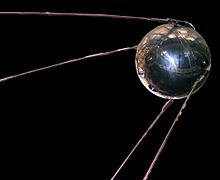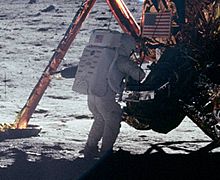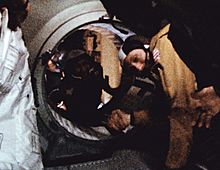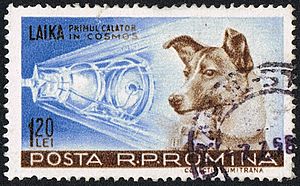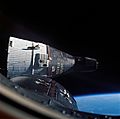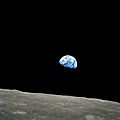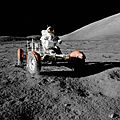Space Race facts for kids
The Space Race was a competition of space exploration between the Soviet Union and the United States, which lasted from 1957 to 1969. It had to do with the efforts to explore outer space with artificial satellites, to send humans into space, and to land them on the Moon. The term "Space Race" started as a comparison to the arms race. The Space Race became an important part of the rivalry between the United States and the Soviet Union during the Cold War. Space technology became an extra important area in this rivalry, because of possible military uses.
The Space Race began after the Soviet launch of Sputnik 1 on 4 October 1957. It gained momentum when the USSR sent the first human, Yuri Gagarin, into space with the orbital flight of Vostok 1 on April 12, 1961. These were followed by a string of other early firsts achieved by the Soviets over the next few years.
Gagarin's flight led US president John F. Kennedy to raise the stakes on May 25, 1961, by asking the US Congress to commit to the goal of "landing a man on the Moon and returning him safely to the Earth" before the end of the decade. Both countries began developing super heavy-lift launch vehicles, with the US successfully deploying the Saturn V, which was large enough to send a three-person orbiter and two-person lander to the Moon. Kennedy's Moon landing goal was achieved in July 1969, with the flight of Apollo 11. The conclusion of Apollo 11 is regarded by many as ending the Space Race with an American victory. This view is contested by some historians, whilst space historian Asif A. Siddiqi proposed a more balanced view. The USSR continued to pursue crewed lunar programs to launch and land on the Moon before the US with its N1 rocket but did not succeed, and eventually canceled it to concentrate on Salyut, the first space station program, and the first landings on Venus and on Mars. Meanwhile, the US landed five more Apollo crews on the Moon and continued exploration of other extraterrestrial bodies robotically.
A period of détente followed with the April 1972 agreement on a cooperative Apollo–Soyuz Test Project (ASTP), resulting in the July 1975 rendezvous in Earth orbit of a US astronaut crew with a Soviet cosmonaut crew and joint development of an international docking standard APAS-75. Being considered as the final act of the Space Race, the competition was only gradually replaced with cooperation. The collapse of the Soviet Union eventually allowed the US and the newly founded Russian Federation to end their Cold War competition also in space, by agreeing in 1993 on the Shuttle–Mir and International Space Station programs.
Contents
First artificial Satellite in Orbit
On 4 October 1957, the Soviet Union launched Sputnik 1, the first artificial satellite to enter the Earth's orbit. This started the Space Race.
First mammals in space
The US and the USSR sent animals into space to determine the safety of the environment before sending the first humans. The USSR used dogs for this purpose, and the US used monkeys and apes. The first mammal in space was Albert II, a rhesus monkey launched by the US on a sub-orbital flight on June 14, 1949, who died on landing due to a parachute malfunction.
The USSR sent the dog Laika into orbit on Sputnik 2 on November 3, 1957, for an intended ten-day flight. They did not yet have the technology to return Laika safely to Earth, and the government reported Laika died when the oxygen ran out, but in October 2002 her true cause of death was reported as stress and overheating on the fourth orbit due to failure of the air conditioning system. At a Moscow press conference in 1998 Oleg Gazenko, a senior Soviet scientist involved in the project, stated "The more time passes, the more I'm sorry about it. We did not learn enough from the mission to justify the death of the dog...".
On August 19, 1960, the dogs Belka and Strelka were sent into orbit aboard Sputnik 5 and safely returned.
The Americans sent the chimpanzee Ham on a suborbital flight of the Mercury capsule on Mercury-Redstone 2 and recovered him safely on January 31, 1961.
The chimpanzee Enos was launched on Mercury-Atlas 5 on November 29, 1961, into what was supposed to be a three-orbit flight. However, the mission was aborted after two orbits due to capsule overheating, and a malfunctioning "avoidance conditioning" test subjecting him to 76 electrical shocks.
First Man in Orbit
One part of the space race was the race to put a man into space. This first was won by the Soviet Union when Major Yuri Gagarin orbited the earth on 12 April 1961.
Gagarin became a national hero of the Soviet Union and the Eastern Bloc, and a worldwide celebrity. Moscow and other cities in the USSR held mass demonstrations, the scale of which was second only to the World War II Victory Parade of 1945. April 12 was declared Cosmonautics Day in the USSR, and is celebrated today in Russia as one of the official "Commemorative Dates of Russia." In 2011, it was declared the International Day of Human Space Flight by the United Nations.
First Men on the Moon
On May 25 1961, in a speech to a joint sitting of congress, President John F Kennedy of the United States of America set the impossible goal of landing a man on the Moon by the end of the decade. This also implied a challenge to the Russians to try to do it first. The Americans won this part of the race in 1969 when Neil Armstrong and Buzz Aldrin landed on the Moon and returned safely to the Earth.
First women in space
The first woman in space was from the Soviet Union, Valentina Tereshkova. NASA did not welcome female astronauts into its corps until 1978, when six female mission specialists were recruited. This first class included scientist Sally Ride, who became America's first woman in space on STS-7 in June 1983. NASA included women mission specialists in the next four astronaut candidate classes, and admitted female pilots starting in 1990. Eileen Collins from this class became the first pilot to fly on Space Shuttle flight STS-63 in February 1995, and the first female commander of a spaceflight on STS-93 in July 1999.
The USSR admitted its first female test pilot as a cosmonaut, Svetlana Savitskaya, in 1980. She became the first female to fly since Tereshkova, on Salyut 7 in December 1981.
First modular space station
The USSR turned its space program to the development of the low Earth orbit modular space station Mir (peace or world) assembled in orbit from 1986 to 1996. At 129,700 kilograms (285,900 lb), it held records for the largest spacecraft and the longest continuous human presence in space at 3,644 days, until the International Space Station was built starting in 1998. Mir's operation continued after the 1991 replacement of the USSR's space program with the Russian Federal Space Agency until 2001, supported by Soyuz spacecraft.
Images for kids
-
Wernher von Braun became the United States' lead rocket engineer during the 1950s and 1960s.
-
The US stable of Explorer 1, Mercury, Gemini, and Apollo launch vehicles were a varied group of ICBMs and the NASA-developed Saturn IB rocket.
-
William Hayward Pickering, James Van Allen, and Wernher von Braun display a full-scale model of Explorer 1 at a Washington, DC news conference after confirmation the satellite was in orbit
-
Alan Shepard, the first American in space, 1961
-
John Glenn, the first American in orbit, 1962
-
Soviet LK (Lunniy Korabl) and American Apollo Lunar Module lunar landers
-
Commemorative plaque and the Fallen Astronaut sculpture left on the Moon in 1971 by the crew of Apollo 15 in memory of 14 deceased NASA astronauts and USSR cosmonauts
-
Earthrise, as seen from Apollo 8, December 24, 1968 (photograph by astronaut William Anders)
-
Neil Armstrong, first person to walk on the Moon, 1969
-
Eugene Cernan rides the Lunar Roving Vehicle during Apollo 17, December 1972
-
Apollo-Soyuz crew: From left to right: Donald "Deke" Slayton, Thomas Patten Stafford, Vance Brand, Alexei Leonov, and Valeri Kubasov
-
Space Shuttle (US) docked to Mir (USSR/Russia) (1995), both products of the ending competition, joined in the Shuttle-Mir program (1993–1998) which facilitated the ongoing International Space Station programme.
See also
 In Spanish: Carrera espacial para niños
In Spanish: Carrera espacial para niños


